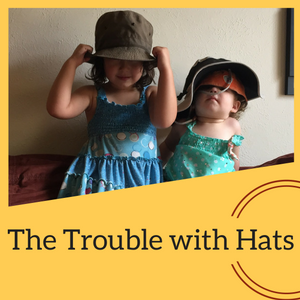 Guest blog by Andrew David Lepp Goff, M.Ed.
Guest blog by Andrew David Lepp Goff, M.Ed.
After all my searching, readings, and talking…I’ve decided it’s time!
Time to remove the hats, or at least prop them up, so that we can have meaningful conversations!
A couple months ago, a colleague introduced me to Universal Design for Learning (UDL)…
A framework to improve and optimize teaching and learning for all people based on scientific insights into how humans learn” (www.cast.org, 2015).
Perfect! Love it! What more could an advocate of inclusion ask for?
But, I needed to understand what UDL looked like in early childhood education (#ECE)…so I started mining the university databases and credible web resources.
NOTHING! Feeling lost, I gave up.
Months later, I stumbled across the term, “Blended Practices.” It was the closest link I could find to UDL in #ECE. I resumed my search for meaning by purchasing a book on blended practices; I participated in a webinar on blended practices; and I read through a monograph on blended practices.
There was no question. UDL fit with Blended Practices, but then…what about Response to Intervention (RTI)?!?!
RTI, you’ve got to be kidding me! I knew RTI from my years in the P-5 schools, but why was I encountering so many triangles and material on RTI when reading about Blended Practices? And how in the world does RTI align with UDL?
Once again, I felt lost. I was clearly missing something.
So I contacted a guru on Blended Practices in search of clarity. Within a half-hour, my troubles were gone (well sort of).
She explained three key points:
- Blended Practices is the big picture…it is what drives instructional decision-making.
- One way of delivering Blended Practices is through a curriculum framework, which includes tiered instruction (hence the triangles and connection to RT).
- UDL is a key component of “tier one” (aka quality instruction) because of the delivery of multiple means for attaining equitable access to learning opportunities for all children.
But, while I was somewhat clearer on the three terms, I wasn’t sure what they meant either individually or collectively for supporting and promoting inclusive practices.
Our conversation concluded with a twist on an old cliché about how we wear “many different hats.” She said, “We all wear many hats and sometimes those hats cover our eyes.”
Meaning, our understanding and ability to apply the essence behind things, like #blended practices, RTI, and UDL, can be obscured by the hats we all wear. For example, researchers and other academics can define the terms; but what’s the use if they are not understood by people who want to put them into practice.
So, after all my searching, readings, and talking…I’ve decided it’s time! Time to remove the hats, or at least prop them up, so that we can have meaningful conversations!
For me, it’s time for those of us working in #ECE and early childhood special education (#ECSE) to push for discussions around the continuity, relationships, and purpose of terms such as #blendedpractices, RTI, and UDL.
Why these terms? Why now?
Well, they, as a collection, are potentially critical to strengthening inclusive programming and practices; but it’s hard to move forward when hats are covering our eyes (i.e., when we are confused, or the meaning of terms vary from one stakeholder group to another).
My hope is that we can shift our focus (mine included), away from time spent on labeling, classifying, and sorting terms into camps, and to more rigorous discussions that will raise our understanding of what terms mean in practice.
I invite you to be part of the discussion…how do you see the terms of #blendedpractices, RTI, and UDL working in concert to change practices around inclusion? What clarity do you seek to fully implement instruction that is for all?
P.S. You can also download your own FREE set of “YOU, ME, WE” cards, which contain prompting questions/guiding questions that allow for deeper reflection on issues related to inclusion.
The guiding questions on each card can be used by an individual to support their inner work and progression toward inclusive practices, or used by faculty, trainers, and coaches to promote discussion and reflection.

Today’s post is from guest blogger – Andrew David Lepp Goff, M.Ed. (@AndrewDLGoff) or LinkedIn. Andrew has been an early childhood special education classroom teacher in urban public schools for nine years. He has grown through the up and downs of inclusion many times over. His passion for inclusive programming and practices has guided his work in school districts, community colleges, and universities. He is currently a doctoral student in the University of Colorado Denver’s Early Childhood Special Education Leadership for Education Equity program. His research interests include the transdisciplinary service delivery model, practices for kindergarten transitions, and the implementation science of evidence based practices that support inclusion.